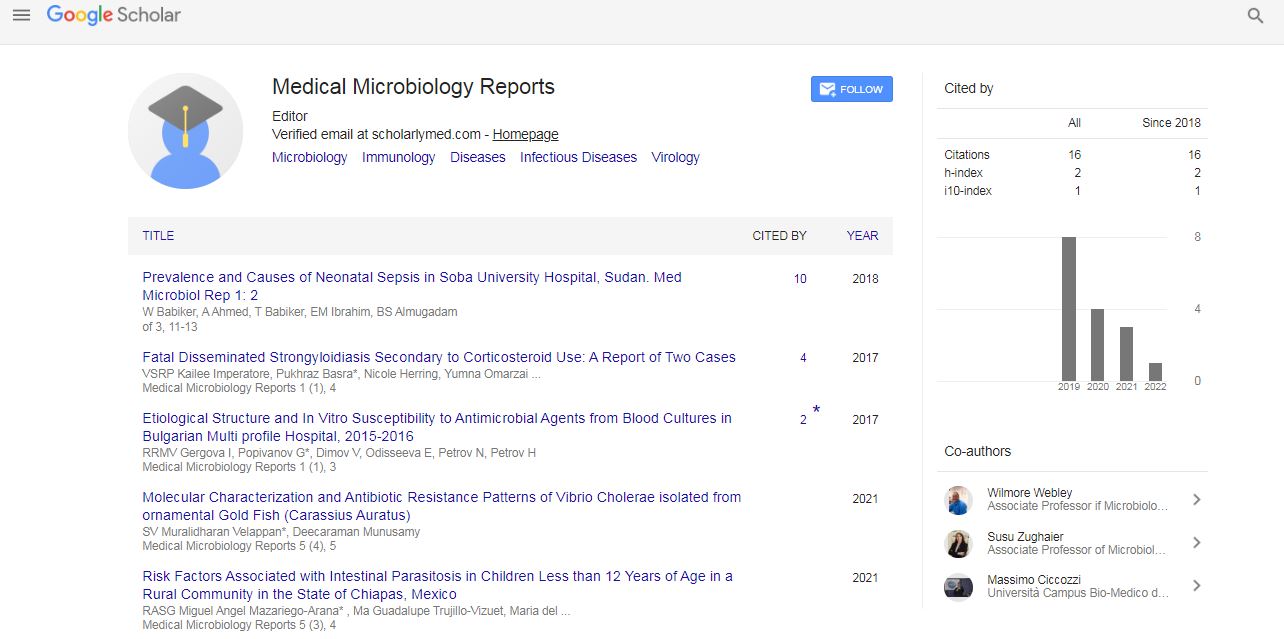Short Communication, Med Microbiol Rep Vol: 5 Issue: 2
Analysis on COVID-19 with mathematical modeling
1School of Science, Hubei University of Technology, Wuhan, Hubei, China
2Hospital, Hubei University of Technology, Wuhan, Hubei, China.
Abstract
Background: An infectious disease caused by a novel coronavirus called COVID-19 has raged across the world since December 2019. The novel coronavirus first appeared in Wuhan, China, and quickly spread to Asia and now many countries around the world are affected by the epidemic. The deaths of many patients, including medical staff, caused social panic, media attention, and high attention from governments and world organizations. Today, with the joint efforts of the government, the doctors and all walks of life, the epidemic in Hubei Province has been brought under control, preventing its spread from affecting the lives of the people. Because of its rapid spread and serious consequences, this sudden novel coronary pneumonia epidemic has become an important social hot spot event. Through the analysis of the novel coronary pneumonia epidemic situation, we can also have a better understanding of sudden infectious diseases in the future, so that we can take more effective response measures, establish a truly predictable and provide reliable and sufficient information for prevention and control model.
Keywords: COVID-19; Pneumonia, Virus, Coronary; differential equation; infectious disease model
Abstract
Background: An infectious disease caused by a novel coronavirus called COVID-19 has raged across the world since December 2019. The novel coronavirus first appeared in Wuhan, China, and quickly spread to Asia and now many countries around the world are affected by the epidemic. The deaths of many patients, including medical staff, caused social panic, media attention, and high attention from governments and world organizations. Today, with the joint efforts of the government, the doctors and all walks of life, the epidemic in Hubei Province has been brought under control, preventing its spread from affecting the lives of the people. Because of its rapid spread and serious consequences, this sudden novel coronary pneumonia epidemic has become an important social hot spot event. Through the analysis of the novel coronary pneumonia epidemic situation, we can also have a better understanding of sudden infectious diseases in the future, so that we can take more effective response measures, establish a truly predictable and provide reliable and sufficient information for prevention and control model.
Methods: We establish different models according to the different developments of the epidemic situation, different time points, and different response measures taken by the government. To be specific, during the period of 2020.1.23-2020.2.7, the traditional SIR model is adopted; during the period of 2020.2.8-2020.3.30, according to the scientific research results, it was considered that the novel coronary pneumonia has a latent period, so in the later phase of epidemic development, the government has effectively isolated patients, thus we adopt the SEIQR model accordingly. During the period of 2020.3.31-2020.5.16, because more asymptomatic infected people were found, we use the SEIQLR model to fit. Finally, through a SEIR simulator, considering the susceptible number, the latent number, the infected number, the cured number, death number and other factors, we simulate the change of various numbers of people from the beginning to the next 180 days of novel coronary pneumonia.
Findings: The results based on the analysis of differential equations and kinetic models show that through the prediction of the model established in the first phase, the epidemic situation of novel coronary pneumonia in Hubei Province was controlled at the end of March, which is in line with the actual situation. The rest of Hubei province, except for Wuhan, lifted control of the departure channel from 0:00 am on March 25, and Wuhan was also unblocked on April 8. Through the establishment of the second-phase model, it is found that the epidemic situation will reach its peak in mid-February. For example, the quarantine admission of the hospital declined after mid-February, which is inseparable from the measures to build square cabin hospitals in early February so that more and more patients can be admitted. The model established in the third phase shows that the epidemic had been completely controlled by the end of May, which is also in line with the reality. Because in mid-May, the Wuhan government conducted a nucleic acid test on all the citizens to screen for asymptomatic infected persons to fundamentally control the spread of novel coronary pneumonia.
Interpretation: Hubei Province, as the centre of the initial outbreak of novel coronary pneumonia, people were forced to be isolated at home during the Spring Festival, the most important Chinese holiday, and the whole society was in a state of suspension of work and study. The Chinese government had taken many measures in response to the epidemic, such as shutting down the city, vigorously building square cabin hospitals, and prohibiting people from gathering. At the beginning of May this year, the epidemic in Hubei Province was finally effectively controlled. For ordinary citizens, we should not cause unnecessary panic about the unknown novel coronavirus. Instead, we should fully understand and be familiar with this virus. In addition to the relevant medical knowledge, we should also understand the spread of infectious diseases through appropriate mathematical models. By mathematical models, we can understand the degree of harm of infectious diseases, when to control it, how to stop it, and use scientific views to reveal the original face of the novel coronavirus to the public without causing social panic.
Keywords
COVID-19; Pneumonia, Virus, Coronary; differential equation; infectious disease model
Introduction
The coronavirus disease 2019 (COVID-19) was first reported in December 2019 in Wuhan, China. It quickly spread to other districts in the country, and a month later, to other countries across the world, impacting over 200 countries and territories1. On March 11, 2020, Tedros, the Director General of the World Health Organization, announced that, based on an assessment, the World Health Organization believes that the current novel coronary pneumonia could be described as a global pandemic2. COVID-19 is a highly contagious respiratory infection caused by a coronavirus that is transmitted primarily through close airborne droplets and contact with a patient's respiratory secretions and close contact, and may also be transmitted through droplet contaminants from a patient (e.g., through hands, clothing, food, water, or the environment). The incubation period of most patients is within 7 days.
Common clinical symptoms of COVID-19 patients include: fever, respiratory symptoms, fatigue, normal or decreased peripheral blood lymphocyte count, and multiple bilateral flaky glass cups around the two lungs in computed tomography (CT) results turbid3. Although the exact source of COVID-19 is still unknown, patients with COVID-19 are by far the most certain source of infection.
As of June 26, 2020, it has been reported that the cumulative number of confirmed cases of COVID-19 in the world has reached 9,690,148, and the cumulative deaths have reached 488, 9714. At this time, there are 68,135 cumulative confirmed cases of COVID-19 and 4,512 cumulative deaths in Hubei Province, China5. The outbreak of COVID-19 has had a great impact on people's lives and the development of the national economy. From March to the present, novel coronary pneumonia has been basically controlled in China. The normal life of the people and the economy affected by the epidemic are recovering.
However, in many areas except China, the epidemic situation is still very serious, and the number of infected people is still high. We analyse Hubei Province, the initial epidemic centre of the new outbreak of pneumonia, and combine with the actual situation in Hubei Province, using different models to provide the world with valuable experience and effective measures in the fight against the epidemic.
In view of the fact that the Chinese government had adopted different policies over time during the fight against the novel coronavirus. When we are modelling, we use different models at different time periods to more effectively conform to the development trend of the epidemic and to respond to changes brought about by policies. Then we use software that could simulate the spread of novel coronavirus, in order to find a result in a theoretical circumstance.
Methods:
Data: The data in this paper on Hubei Province are from authoritative data published by the Hubei Provincial Health Planning Commission on its official platform from January 23, 2020 to May 16, 20206. Data include cumulative diagnosed cases, cumulative deaths, cumulative cures, suspected cases, and asymptomatic infections, etc., and get Hubei Province's 2019 total population from official sources7.
The data we collect is very large, so we must process and analyse the large amount of data collected. The approach is to use Excel to determine the data categories, and then we use MATLAB to further optimize the parameters so that we can effectively use these data to gain the results. The specific operation is: according to the known data, filter the data and through basic operations in Excel to get the data we actually need. Then bring these data into MATLAB to calculate, get the optimized parameter value through fmincon function.
 Spanish
Spanish  Chinese
Chinese  Russian
Russian  German
German  French
French  Japanese
Japanese  Portuguese
Portuguese  Hindi
Hindi 
